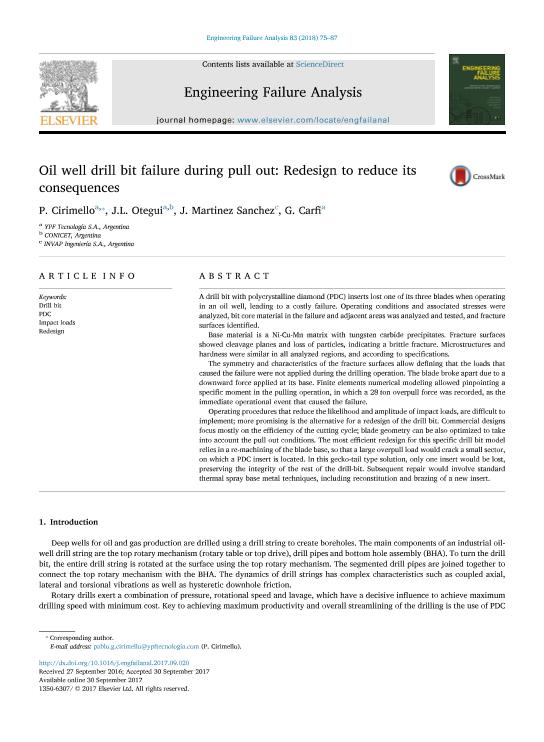Mostrar el registro sencillo del ítem
dc.contributor.author
Cirimello, Pablo Gabriel

dc.contributor.author
Otegui, Luis Jose

dc.contributor.author
Sanchez Martinez, Julio

dc.contributor.author
Carfi, Guillermo Rodolfo

dc.date.available
2020-03-12T19:37:50Z
dc.date.issued
2018-01
dc.identifier.citation
Cirimello, Pablo Gabriel; Otegui, Luis Jose; Sanchez Martinez, Julio; Carfi, Guillermo Rodolfo; Oil well drill bit failure during pull out: Redesign to reduce its consequences; Pergamon-Elsevier Science Ltd; Engineering Failure Analysis; 83; 1-2018; 75-87
dc.identifier.issn
1350-6307
dc.identifier.uri
http://hdl.handle.net/11336/99333
dc.description.abstract
A drill bit with polycrystalline diamond (PDC) inserts lost one of its three blades when operating in an oil well, leading to a costly failure. Operating conditions and associated stresses were analyzed, bit core material in the failure and adjacent areas was analyzed and tested, and fracture surfaces identified. Base material is a Ni-Cu-Mn matrix with tungsten carbide precipitates. Fracture surfaces showed cleavage planes and loss of particles, indicating a brittle fracture. Microstructures and hardness were similar in all analyzed regions, and according to specifications. The symmetry and characteristics of the fracture surfaces allow defining that the loads that caused the failure were not applied during the drilling operation. The blade broke apart due to a downward force applied at its base. Finite elements numerical modeling allowed pinpointing a specific moment in the pulling operation, in which a 28 ton overpull force was recorded, as the immediate operational event that caused the failure. Operating procedures that reduce the likelihood and amplitude of impact loads, are difficult to implement; more promising is the alternative for a redesign of the drill bit. Commercial designs focus mostly on the efficiency of the cutting cycle; blade geometry can be also optimized to take into account the pull out conditions. The most efficient redesign for this specific drill bit model relies in a re-machining of the blade base, so that a large overpull load would crack a small sector, on which a PDC insert is located. In this gecko-tail type solution, only one insert would be lost, preserving the integrity of the rest of the drill-bit. Subsequent repair would involve standard thermal spray base metal techniques, including reconstitution and brazing of a new insert.
dc.format
application/pdf
dc.language.iso
eng
dc.publisher
Pergamon-Elsevier Science Ltd

dc.rights
info:eu-repo/semantics/openAccess
dc.rights.uri
https://creativecommons.org/licenses/by-nc-sa/2.5/ar/
dc.subject
DRILL BIT
dc.subject
IMPACT LOADS
dc.subject
PDC
dc.subject
REDESIGN
dc.subject.classification
Otras Ingeniería de los Materiales

dc.subject.classification
Ingeniería de los Materiales

dc.subject.classification
INGENIERÍAS Y TECNOLOGÍAS

dc.title
Oil well drill bit failure during pull out: Redesign to reduce its consequences
dc.type
info:eu-repo/semantics/article
dc.type
info:ar-repo/semantics/artículo
dc.type
info:eu-repo/semantics/publishedVersion
dc.date.updated
2020-03-03T15:05:27Z
dc.journal.volume
83
dc.journal.pagination
75-87
dc.journal.pais
Países Bajos

dc.journal.ciudad
Amsterdam
dc.description.fil
Fil: Cirimello, Pablo Gabriel. YPF - Tecnología; Argentina
dc.description.fil
Fil: Otegui, Luis Jose. Consejo Nacional de Investigaciones Científicas y Técnicas; Argentina. YPF - Tecnología; Argentina
dc.description.fil
Fil: Sanchez Martinez, Julio. Invap S. E.; Argentina
dc.description.fil
Fil: Carfi, Guillermo Rodolfo. YPF - Tecnología; Argentina
dc.journal.title
Engineering Failure Analysis

dc.relation.alternativeid
info:eu-repo/semantics/altIdentifier/url/https://www.sciencedirect.com/science/article/pii/S1350630716308391
dc.relation.alternativeid
info:eu-repo/semantics/altIdentifier/doi/http://dx.doi.org/10.1016/j.engfailanal.2017.09.020
Archivos asociados
